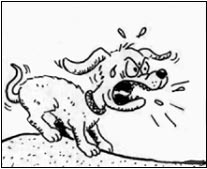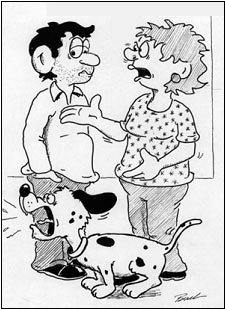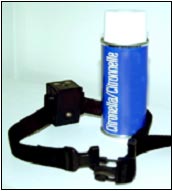|
Why
do dogs bark?
Barking
is one of the most common complaints
of dog owners and their neighbors!
But barking is natural. It can
serve as a territorial warning
signal to other dogs and pack
members. Dogs may vocalize when
separated from their pack or
family members. Barking also
occurs during times of indecision,
anxiety, or frustration. Medical
problems can also contribute
to vocalization, especially
in the older dog.
How
can barking problems be prevented?
Socialization
and habituation
— get puppies used to
as many new people, animals,
situations and noises as possible.
This will minimize the amount
or intensity of alarm barking.
Barking should only be allowed
to alert owners and then be
controlled and stopped before the dog becomes agitated
and out of control. Owner control,
training and leadership are
essential (see our handout on
‘Puppy training - taking
charge').
before the dog becomes agitated
and out of control. Owner control,
training and leadership are
essential (see our handout on
‘Puppy training - taking
charge').
How
can I stop my dog barking when
I leave?
Effective
portable kennel training techniques
when your dog is first obtained,
should decrease the dog's
anxiety when it is left alone
in its kennel (see our handout
on ‘House safety and kennel
training'). Your dog should
gradually be taught to spend
longer periods of time away
from you. Obtaining two dogs
may provide company for each
other and may reduce distress
vocalization and departure anxiety.
If your dog has been barking
when you leave for some time,
he may be suffering from separation
anxiety and you should consult
your veterinarian for treatment
options.
My
dog constantly barks. What does
she want?
Attention
getting barking can be problematic
and is often reinforced by owners
giving in to their dog's
demands. Allowing a barking
dog indoors, or feeding, patting,
praising, playing with, giving
a toy, or even just going to
a barking dog to try and quiet
it down, are just a few examples
of how an owner may unknowingly
reinforce barking. Never reward
barking with any type of attention,
even occasionally.
How
can I train my dog to be ‘quiet'?
Training
the dog to a "quiet"
command is an invaluable aid
for controlling undesirable
barking. You must find an effective
means of quieting the dog, which
should be preceded with a command
such as ‘quiet'.
Just loudly telling your pet
to ‘be quiet', will
probably not be understood,
especially if silence does not
follow the verbal command. In
fact, yelling may just add to
the noise and anxiety, thereby
encouraging your dog to bark
more.
One
of the most practical techniques
for teaching a dog to cease
barking on command, is to first,
be able to command the dog to
begin barking on cue. Use a
stimulus that will cause the
dog to bark and pair it with
a ‘bark' command.
Numerous repetitions allow the
dog to associate the word ‘bark'
or ‘speak' with
the action. Dogs that bark on
command can then be taught to
turn off the barking by removing
the cue or stimulus, and giving
a ‘hush' or ‘quiet'
command just before the barking
subsides. As soon as your dog
is quiet, give a favored treat
or reward.
It
can be difficult or impractical
to teach a dog to be ‘quiet'
on command if the barking cannot
be predicted or ‘turned
on' or if it is too intense.
Another
method to teach a "quiet"
command is to wait until your
dog is barking, say to a doorbell
and while he is barking place
a very tasty food treat by his
nose. Most dogs will stop barking
to sniff the treat. At the same
time you must say the word you
will use for quiet, such as
‘silent', ‘hush'
etc. When the dog is quiet (as
they will be because dogs cannot
sniff and bark at the same time)
you can praise him, say ‘good,
quiet' and give the treat.
Again, as with all new tasks,
numerous repetitions are necessary
for lasting learning.
 Alternately,
distraction or remote punishment
devices (see below) can be used
to disrupt the barking. One
of the most effective means
of interrupting barking and
ensuring quiet is a remote leash
and head halter. A pull on the
leash disrupts the dog and closes
the mouth, which should also
coincide with a verbal command
such as ‘quiet'
or ‘hush'. Quiet
behavior can then be reinforced
first by releasing and then
giving a reinforcer such as
praise or food if the dog remains
quiet. Soon the dog should associate
the closed mouth and the word
prompt with the absence of noise
and begin to stop barking when
given the verbal prompt alone. Alternately,
distraction or remote punishment
devices (see below) can be used
to disrupt the barking. One
of the most effective means
of interrupting barking and
ensuring quiet is a remote leash
and head halter. A pull on the
leash disrupts the dog and closes
the mouth, which should also
coincide with a verbal command
such as ‘quiet'
or ‘hush'. Quiet
behavior can then be reinforced
first by releasing and then
giving a reinforcer such as
praise or food if the dog remains
quiet. Soon the dog should associate
the closed mouth and the word
prompt with the absence of noise
and begin to stop barking when
given the verbal prompt alone.
What
are my chances of correcting
my dog's barking problem?
Chances
are good for most barking problems.
But the household situation
in which the dog resides may
make it extremely difficult
to correct completely. Even
a small amount of barking could
disturb a sleeping baby, or
upset neighbors, (particularly
in apartments or townhouses).
When trying to resolve barking
problems, the motivation for
the barking behavior is an important
component. Some stimuli are
so strong that it will be difficult
to stop the barking behavior.
You need sufficient time to
implement the correction training.
What
can I do to correct my dog's
barking problem?
The
treatment program must be based
on the type of problem, your
household, the immediacy of
the situation, and the type
and level of control that you
require. A good behavioral history
is important to determine cause,
motivation and potential reinforcing
stimuli for the barking behavior.
Treatment plans need to consider
the following:
1.
Ensure that your dog is not
being rewarded inadvertently.
Some owners in an attempt to
calm their dog down will actually
encourage the barking by giving
attention, play, food or affection.
2.
Insure that your response is
not aggravating the problem.
For example yelling at a dog
that is barking due to anxiety
or as a territorial response
is only likely to increase the
dog's barking and anxiety.
3.
Sometimes the home environment
can be modified so that the
dog is kept away from the stimuli
(sounds and sights) that cause
barking. Exposure might be minimized
by confining the dog to a kennel,
or room away from doors and
windows or covering windows
so that the dog cannot look
outside. Additionally, privacy
fencing may be helpful for dogs
outdoors. Dogs that bark when
left alone outdoors may have
to be kept indoors except when
the owner is available to supervise.
Trigger sounds such as doorbells
or telephones that might have
become conditioned stimuli for
barking should be altered to
change their sound.
4.
Until effective control and
leadership is established, training
programs are unlikely to be
successful. Increasing interactive
play periods and exercise, kennel
and confinement training, halter
training and obedience classes
may need to be implemented before
bark control training can begin.
5.
Once you have sufficient control
and the dog responds to obedience
commands and  handling,
it should be possible to train
your dog to cease barking on
command. Training the dog to
cease barking on command can
be accomplished with lure reward
techniques, distraction techniques,
or halter and leash training.
Regardless of the technique,
rewards should be given as soon
as the barking stops, so that
the dog learns that quiet behavior
earns rewards. It is most important
to associate SILENCE with the
command used. Over time the
behavior should be shaped so
that the dog is required to
stay quiet for progressively
longer times, before a reward
is given. handling,
it should be possible to train
your dog to cease barking on
command. Training the dog to
cease barking on command can
be accomplished with lure reward
techniques, distraction techniques,
or halter and leash training.
Regardless of the technique,
rewards should be given as soon
as the barking stops, so that
the dog learns that quiet behavior
earns rewards. It is most important
to associate SILENCE with the
command used. Over time the
behavior should be shaped so
that the dog is required to
stay quiet for progressively
longer times, before a reward
is given.
6.
Once the owner has sufficient
control with training and the
quiet command, it may then be
possible to begin a retraining
program in the presence of the
stimuli (people, other dogs)
that lead to barking. Training
with a head halter and leash
often provides a tool for implementing
the techniques safely and effectively
especially indoors or when the
owner is nearby. The stimulus
should first be presented to
the dog from a distance (e.g.
children riding bicycles on
the street while the dog stands
on its porch), and the dog given
a quiet or sit-stay command.
Although the halter and leash
is generally all that is required
to control the dog and achieve
the appropriate response, the
dog could also be disrupted
using a device such as an ultrasonic
trainer or shake can. Training
sessions are then repeated with
progressively more intense stimuli.
This type of training can be
effective, but progress can
be slow and time consuming.
7.
Pets that are barking for other
reasons (fear, separation anxiety,
or compulsive disorders) will
require treatment for the underlying
problem.
Should
I punish my dog when she keeps
barking?
Punishment
is seldom effective in the control
and correction of barking problems.
Excessive levels of punishment
can increase anxiety and further
aggravate many forms of barking,
while mild punishment merely
rewards the behavior by providing
attention.
What anti-barking
devices are there and are they
effective?
Owner-Activated
Products: These products
are most useful for getting
the pet's attention (disruption)
during quiet command training.
Ultrasonic devices (Pet Agree™,
Easy Trainer™), audible
devices (Barker Breaker™,
rape alarms), water sprayers,
or a shake can (an empty peanut
or soda can with a few coins
or pebbles sealed inside) are
often successful. Without concurrent
retraining techniques and an
owner with good control, many
dogs will soon begin to ignore
the devices. However, if the
device is used to interrupt
the barking and the quiet behavior
is then reinforced, the pet
may become less anxious and
less likely to bark in the presence
of the stimulus, or at the very
least will quiet much faster
on command.
Bark-Activated
Products: When barking
occurs in the owner's
absence, bark activated products
(in conjunction with environmental
modification and retraining)
are often the most practical
means of deterring inappropriate
barking. Bark-activated products
may also be a better choice
than owner-activated devices,
since they ensure immediate
and accurate timing. Off-collar
devices are useful for training
the dog to cease barking in
selected areas, such as near
doorways or windows, (or for
dogs that bark in their kennel
or pen). The Super Barker Breaker
emits an audible alarm while
the Yapper Zapper™ sprays
a stream of water each time
the dog barks.
 Bark-activated
collars are useful
when barking does not occur
in a predictable location. Audible
and ultrasonic training collars
are occasionally effective but
they are neither sufficiently
unpleasant nor consistent enough
to be a reliable deterrent.
The Aboistop™ or Gentle
Spray™ collar emits a
spray of citronella each time
the dog barks and is sufficiently
unpleasant to deter most dogs.
Although these may be effective
in the owner's absence,
they have their most lasting
effects when the owner is present
to supervise and retrain. As
soon as the barking ceases,
the owner should direct the
dog into an enjoyable pastime
(e.g. play, tummy rub, favorite
treat) as long as the dog remains
quiet. . Soon the dog may associate
the stimulus (people coming
to the door, people coming to
the yard) with something positive. Bark-activated
collars are useful
when barking does not occur
in a predictable location. Audible
and ultrasonic training collars
are occasionally effective but
they are neither sufficiently
unpleasant nor consistent enough
to be a reliable deterrent.
The Aboistop™ or Gentle
Spray™ collar emits a
spray of citronella each time
the dog barks and is sufficiently
unpleasant to deter most dogs.
Although these may be effective
in the owner's absence,
they have their most lasting
effects when the owner is present
to supervise and retrain. As
soon as the barking ceases,
the owner should direct the
dog into an enjoyable pastime
(e.g. play, tummy rub, favorite
treat) as long as the dog remains
quiet. . Soon the dog may associate
the stimulus (people coming
to the door, people coming to
the yard) with something positive.
Most
importantly, bark collars only
work when they are on the dog.
Most dogs will learn to distinguish
when the collar is on and when
it is off. When they are not
wearing the collar, most dogs
will bark.
Is
debarking surgery effective?
Surgical
debarking is a drastic and often
permanent method of eliminating
barking. Varying degrees of
vocalization may return as the
surgical site heals and scars.
Devocalization may need to be
considered when owners are confronted
with the option of immediately
resolving a barking problem
or having to give up their pet.
However, all attempts at behavior
modification should be continued
to try and address the underlying
motivation for barking and perhaps
effect a permanent solution.
This client
information sheet is based on
material written by Debra Horwitz,
DVM, DACVB and
Gary Landsberg, DVM, DACVB.
© Copyright 2002 Lifelearn
Inc. Used with permission under
license. March 11, 2004. |